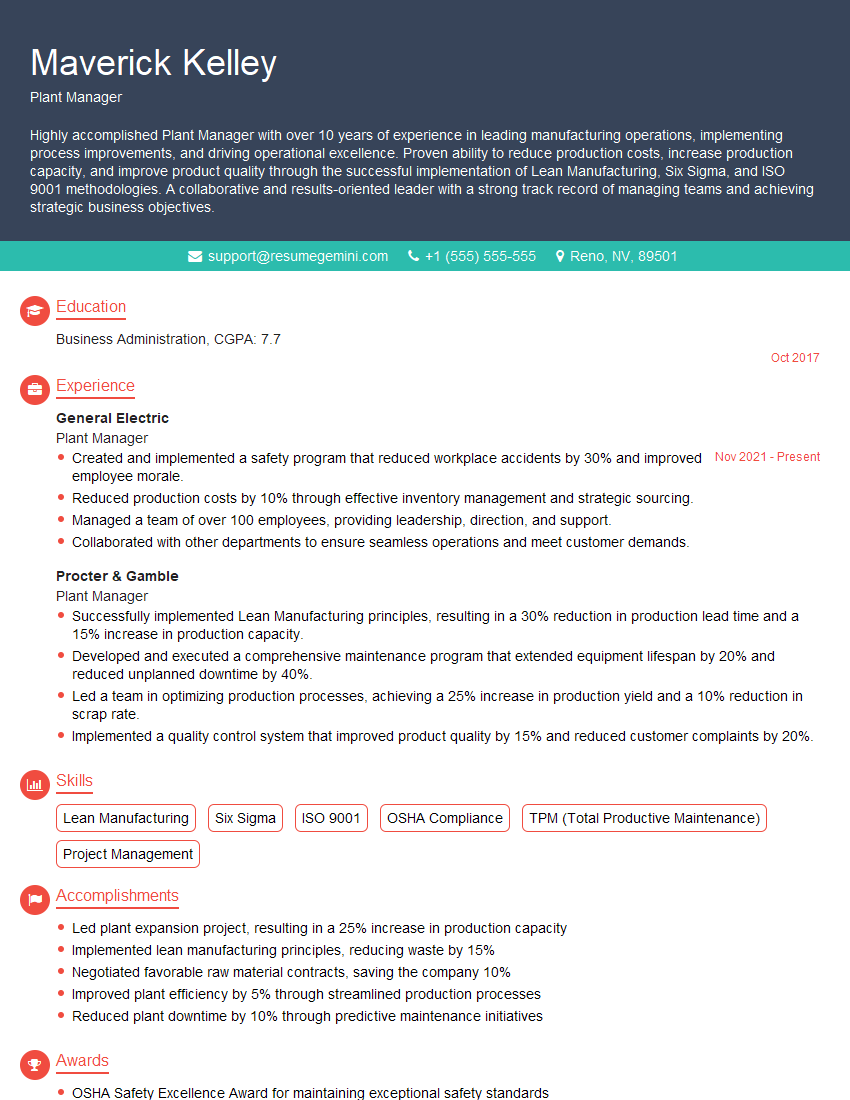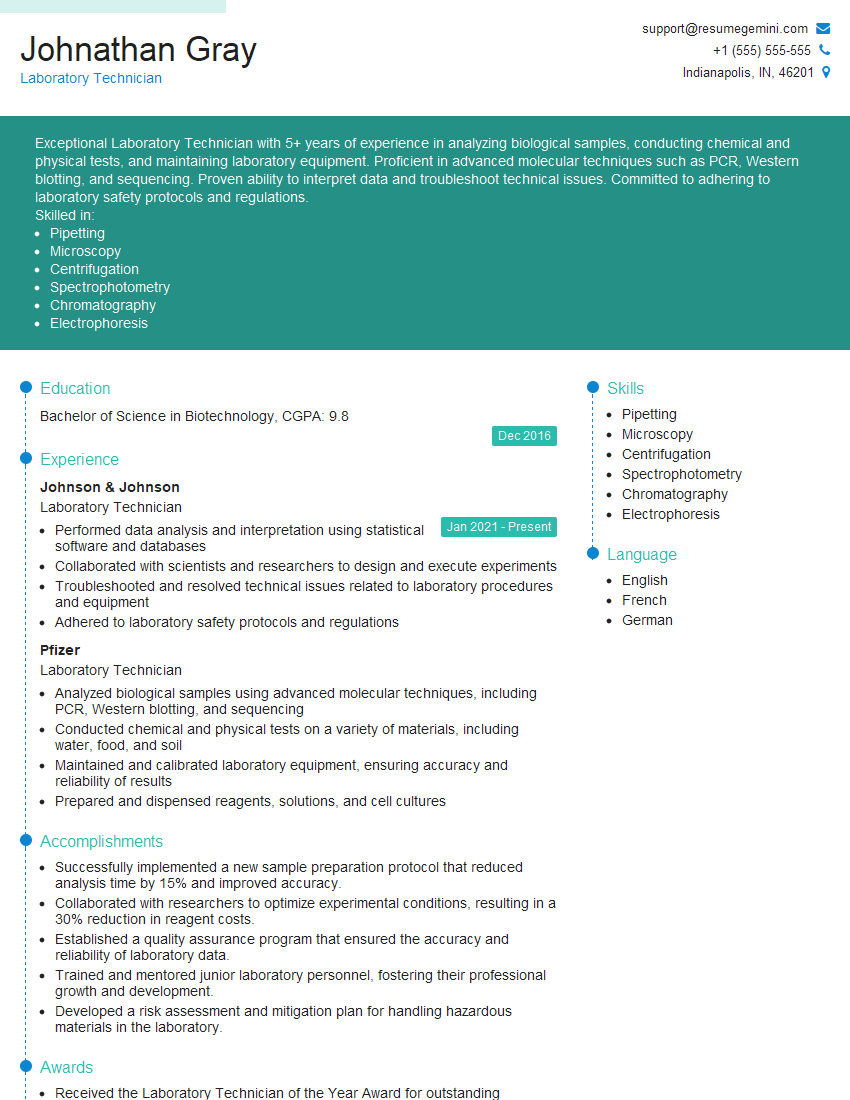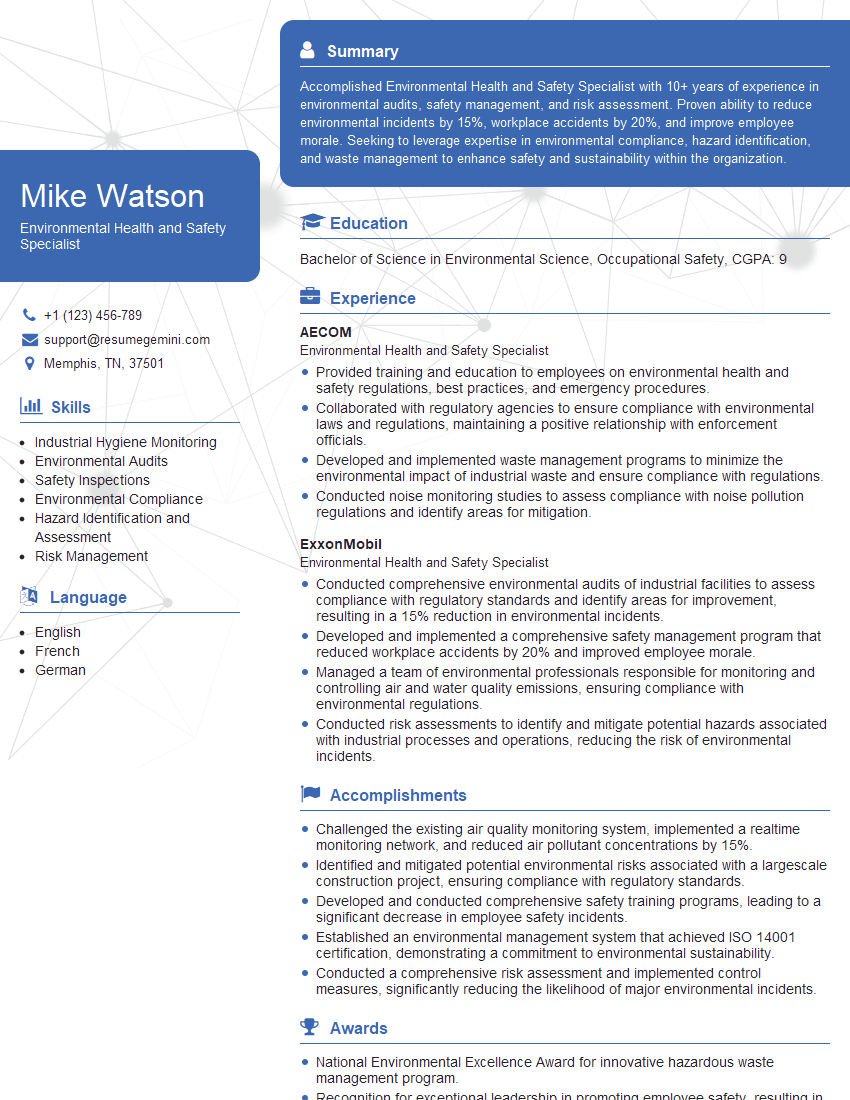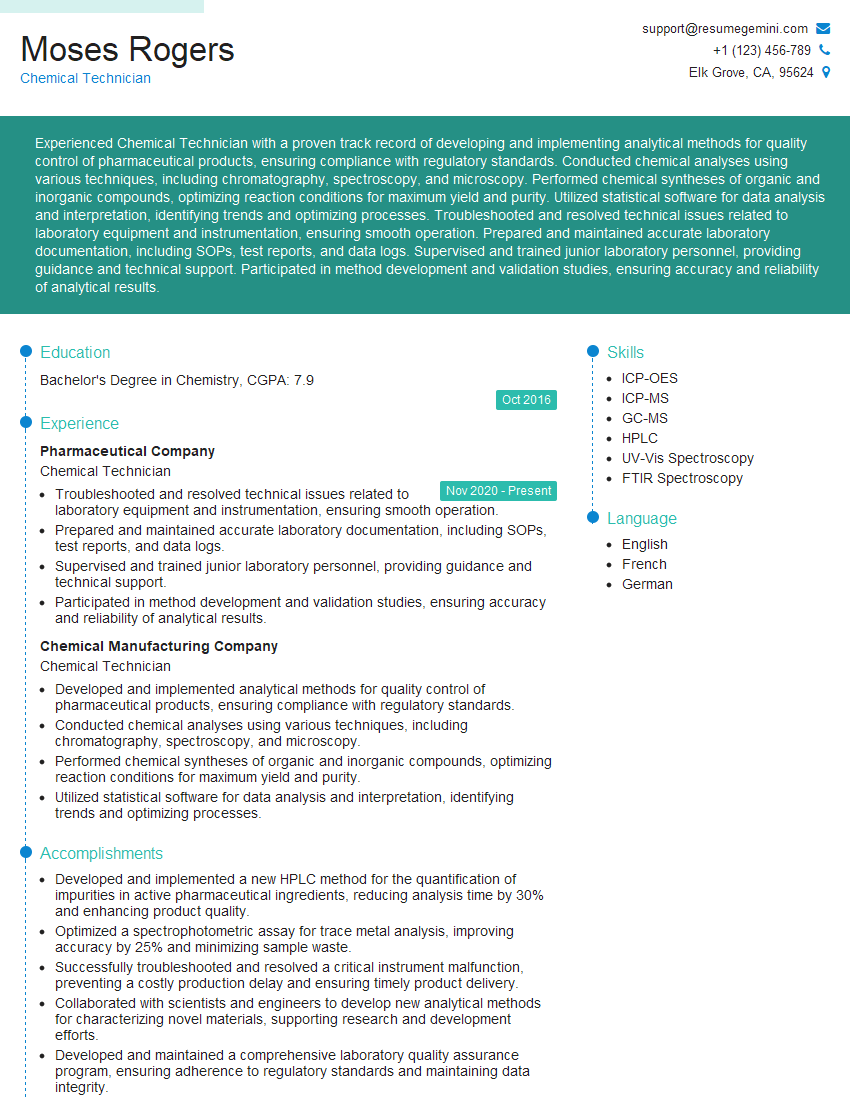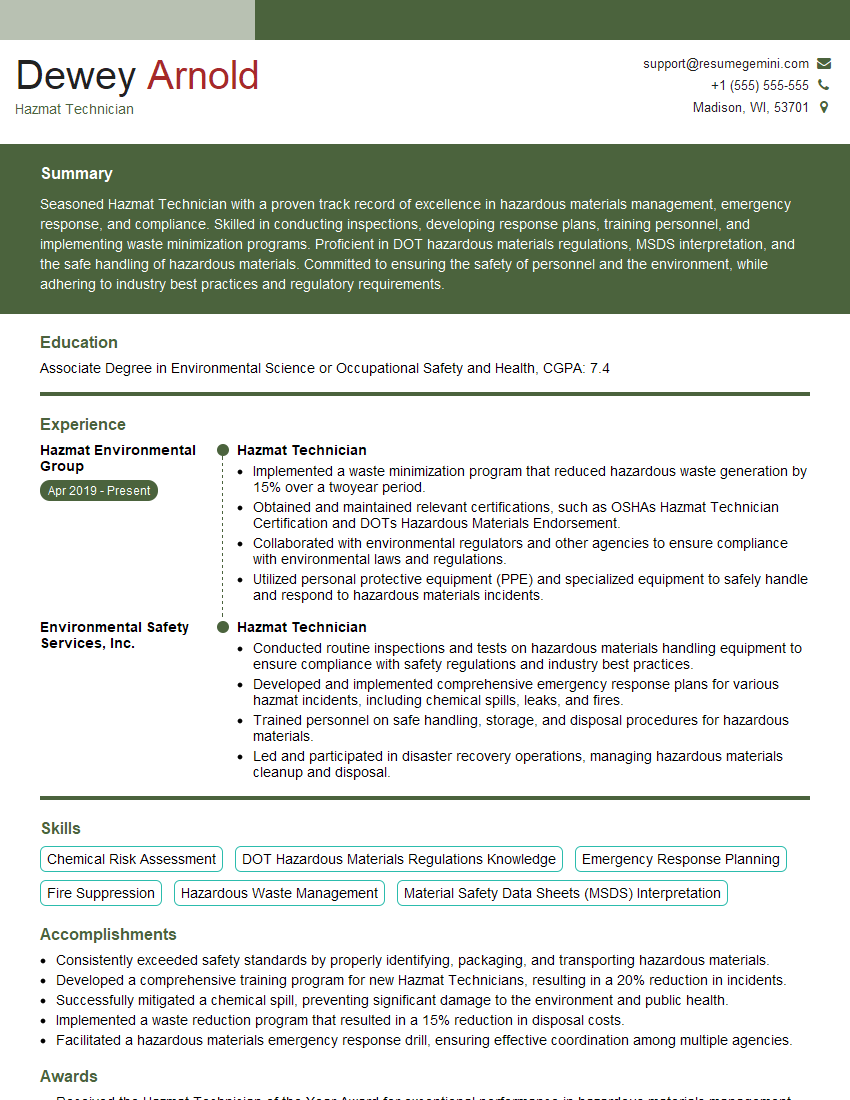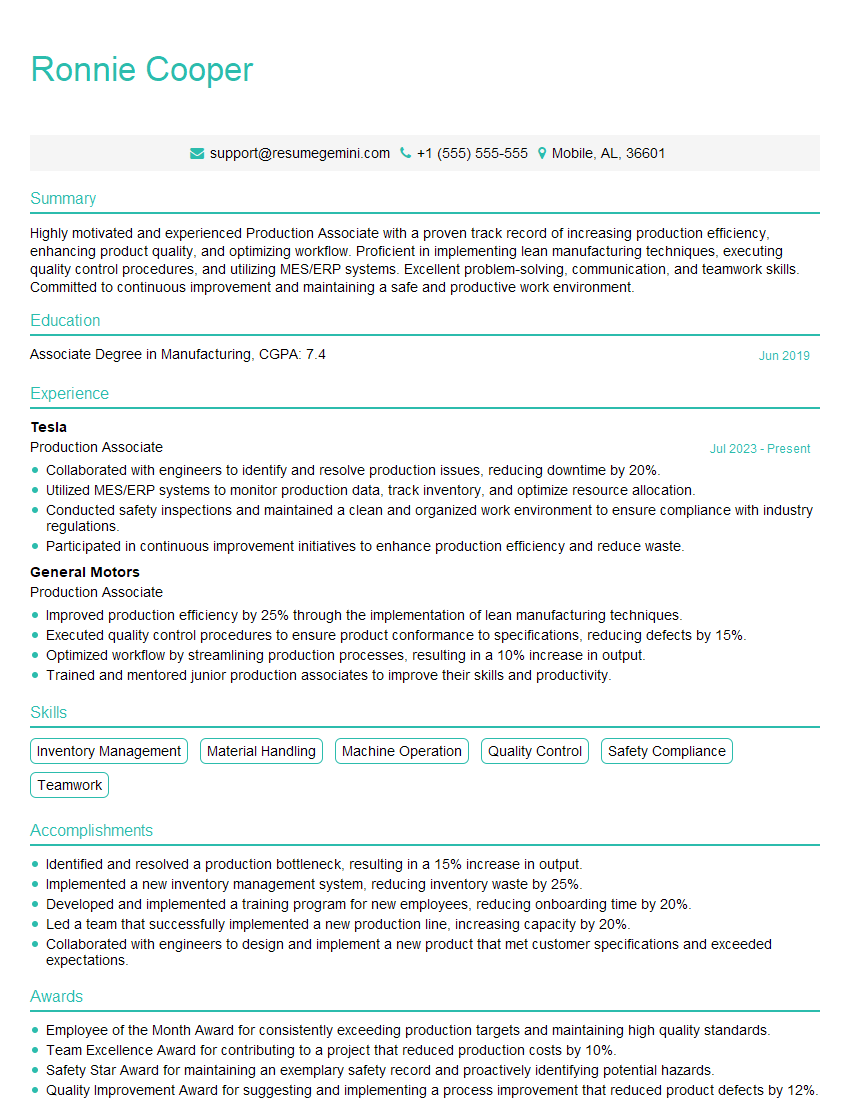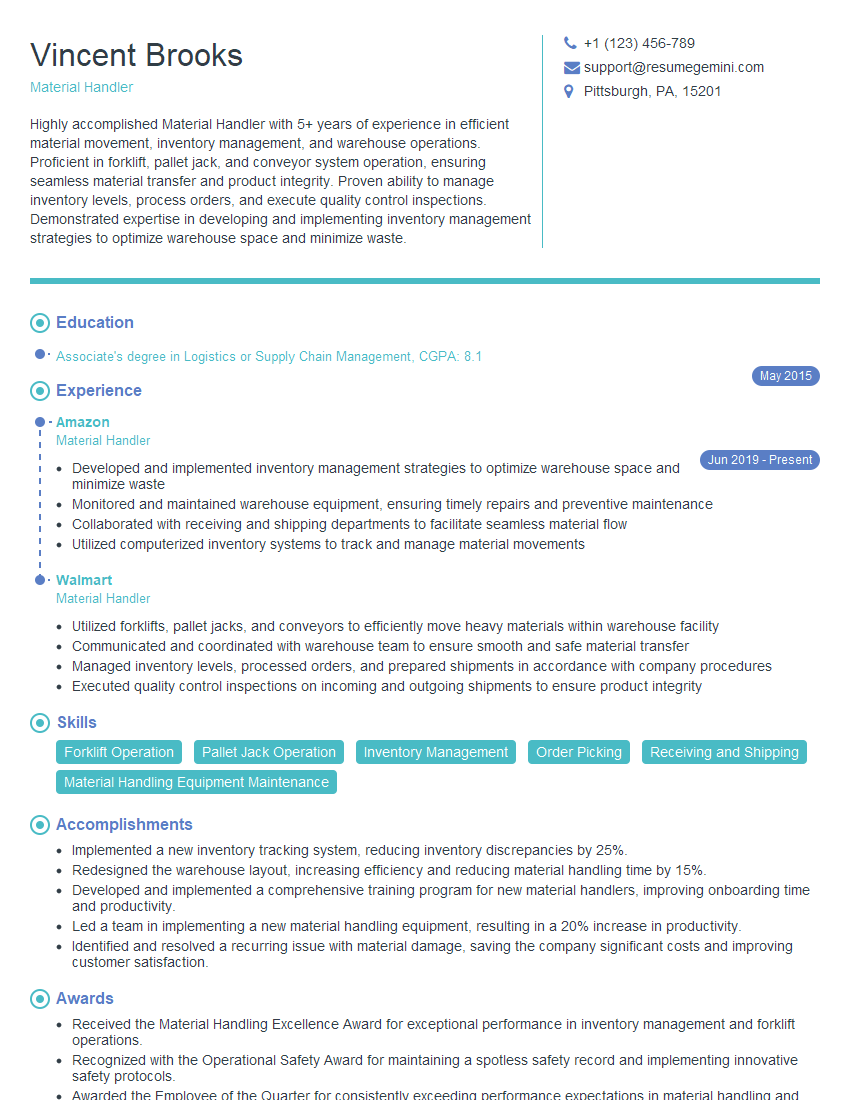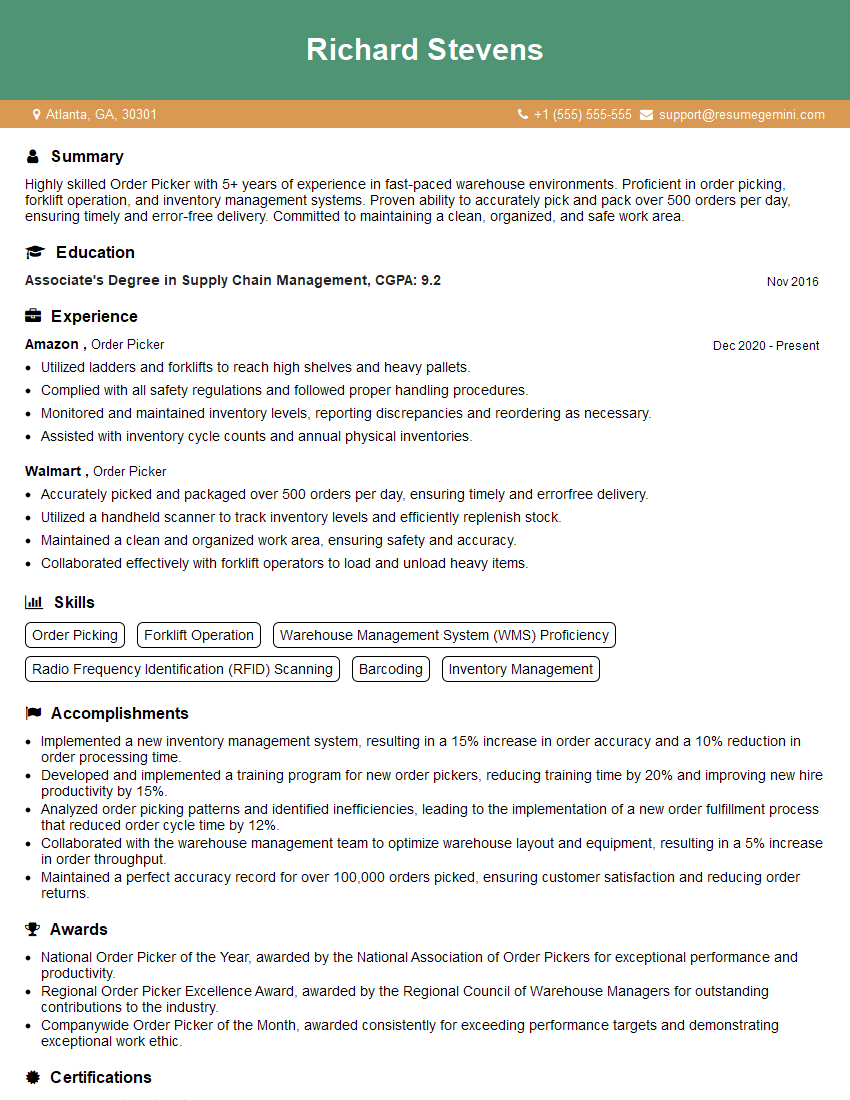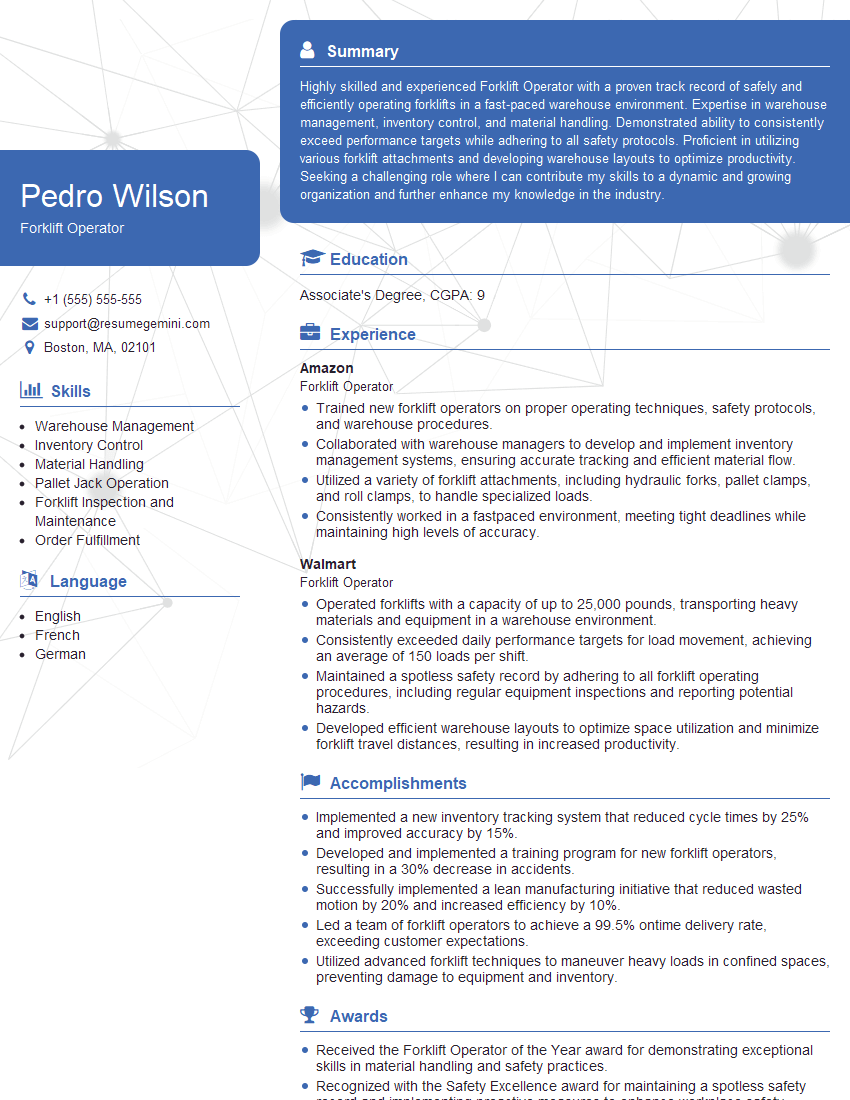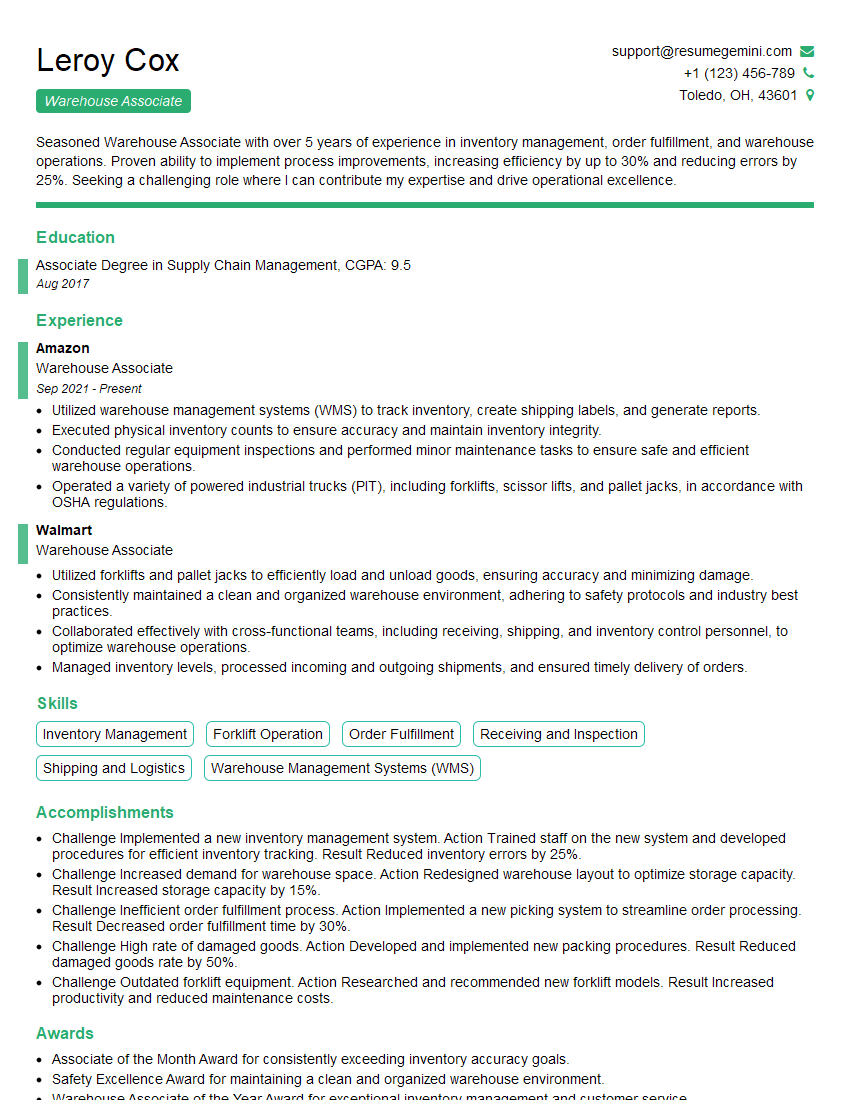The thought of an interview can be nerve-wracking, but the right preparation can make all the difference. Explore this comprehensive guide to Material and Chemical Handling interview questions and gain the confidence you need to showcase your abilities and secure the role.
Questions Asked in Material and Chemical Handling Interview
Q 1. Explain the different types of material handling equipment you are familiar with.
Material handling equipment encompasses a wide range of machinery and tools used to move, store, and control materials throughout a facility. My experience includes working with various types, categorized for clarity:
- Conveyors: These automated systems move materials efficiently, ranging from simple belt conveyors for boxes to complex roller conveyors for heavier items. I’ve used them in warehouse settings to streamline order fulfillment.
- Forklifts: Essential for lifting and transporting pallets and other heavy loads. I’m proficient in operating both sit-down and stand-up forklifts, adhering strictly to safety protocols, and have extensive experience in various forklift types including counterbalance, reach trucks, and order pickers.
- Cranes: Used for lifting extremely heavy or bulky materials. My experience involves working safely with overhead cranes and understanding load capacity limits. I have experience with both manual and automated crane systems.
- Hoists: These are essential for lifting materials vertically, often used in conjunction with cranes or other lifting equipment. I’m familiar with chain hoists, electric hoists and their maintenance.
- Automated Guided Vehicles (AGVs): These robots navigate a facility autonomously, transporting materials along pre-programmed routes. I’ve been involved in the implementation and monitoring of AGVs in a large distribution center, improving efficiency and reducing manual labor.
- Pallet Jacks: Manual equipment used for moving pallets over short distances. While seemingly simple, proficiency in safe operation is crucial to avoid accidents.
Understanding the capabilities and limitations of each type of equipment is crucial for efficient and safe material handling operations.
Q 2. Describe your experience with inventory management systems.
My experience with inventory management systems includes hands-on work with both enterprise-level software (like SAP and Oracle) and simpler, custom-built systems. I’m proficient in using these systems to track material movement, monitor stock levels, manage reordering points, and generate reports for analysis.
For example, in a previous role, we implemented a barcode scanning system integrated with our inventory management software. This significantly improved accuracy in tracking inventory, reduced discrepancies, and sped up the picking and packing process. We also used the system to generate real-time alerts when stock levels reached critical points, enabling proactive reordering and avoiding stockouts.
Beyond data entry and retrieval, I understand the importance of data integrity and regularly perform audits to ensure accuracy. I also have experience developing and implementing inventory control procedures to minimize waste and optimize storage space. This includes techniques like FIFO (First-In, First-Out) and FEFO (First-Expired, First-Out) for managing perishable goods.
Q 3. How do you ensure the safety of materials during handling and storage?
Ensuring material safety during handling and storage is paramount. My approach is multi-faceted:
- Proper Packaging and Labeling: Materials should be appropriately packaged to prevent damage during transport and storage, clearly labeled with identification, hazard warnings (if applicable), and handling instructions.
- Safe Storage Practices: Materials should be stored in designated areas based on compatibility, weight, and hazard class. Proper racking systems, appropriate stacking methods, and adequate aisle space are critical to prevent collapses and accidents.
- Equipment Maintenance: Regular inspections and maintenance of material handling equipment are essential. Malfunctioning equipment can lead to accidents, so proactive maintenance is a crucial safety measure.
- Training and Procedures: All personnel involved in material handling should receive comprehensive training on safe operating procedures, including the use of personal protective equipment (PPE) and emergency response plans.
- Regular Inspections: Routine inspections of storage areas and equipment can identify potential hazards before they lead to accidents. This proactive approach is key.
I always prioritize safety, and I’m comfortable developing and implementing comprehensive safety programs aligned with relevant regulations (OSHA, etc.).
Q 4. What are the common hazards associated with chemical handling and how do you mitigate them?
Chemical handling presents various hazards, including:
- Toxicity: Many chemicals are poisonous if ingested, inhaled, or absorbed through the skin. This necessitates proper PPE (e.g., respirators, gloves, protective clothing).
- Flammability: Flammable chemicals pose a fire risk. Storage areas must be well-ventilated and away from ignition sources. Proper handling procedures and fire suppression systems are critical.
- Reactivity: Some chemicals react violently with each other or with water, leading to explosions or fires. Incompatible chemicals must be stored separately.
- Corrosivity: Corrosive chemicals can damage skin, eyes, and equipment. Appropriate handling procedures and protective equipment are essential.
Mitigation strategies involve:
- SDS Review: Always consult the Safety Data Sheet (SDS) for each chemical to understand its hazards and appropriate handling procedures.
- Proper Ventilation: Ensure adequate ventilation to minimize inhalation hazards. Local exhaust ventilation near chemical handling areas is often necessary.
- PPE Use: Appropriate PPE must be used based on the specific chemical hazards and work tasks. Training on proper PPE use is crucial.
- Spill Response Plans: Develop and regularly practice spill response plans to effectively handle chemical spills and prevent environmental contamination.
- Emergency Showers and Eyewash Stations: These must be readily accessible in areas where chemicals are handled.
My experience in managing chemical handling involves the diligent implementation of all these strategies to maintain a safe working environment.
Q 5. Describe your experience with hazardous materials (Hazmat) handling procedures.
My experience with hazardous materials (Hazmat) handling encompasses a thorough understanding of relevant regulations (e.g., DOT, OSHA) and the implementation of safe handling, storage, and transportation procedures. This includes:
- Proper Classification and Labeling: Accurately classifying and labeling Hazmat according to their hazard class is essential for safe handling and transportation. I am familiar with the UN hazard classification system.
- Emergency Response Plans: Developing and practicing emergency response plans for potential Hazmat incidents, including spills, leaks, and fires. This includes training personnel on emergency procedures and having readily available equipment.
- Transportation Regulations: Adherence to all relevant transportation regulations, including the proper documentation and placarding of Hazmat shipments. My experience includes managing and ensuring compliance with shipping manifests and documentation.
- Specialized Equipment: Using specialized equipment designed for handling Hazmat, such as spill containment kits and specialized protective clothing.
- Waste Disposal: Following proper procedures for the safe disposal of Hazmat waste, in accordance with all applicable environmental regulations.
I have a strong focus on risk assessment and mitigation to ensure the safety of personnel and the environment. My experience includes working with a variety of Hazmat materials, including corrosive substances, flammable liquids, and toxic chemicals.
Q 6. What is your experience with different types of storage containers and their suitability for various materials?
The choice of storage containers depends heavily on the material being stored. My experience spans a range of containers:
- Drums (55-gallon): Common for liquids and powders. Steel drums are durable but can rust; plastic drums are lighter and less prone to rust, but may not be suitable for all chemicals. The choice depends on the chemical compatibility.
- IBC Totes (Intermediate Bulk Containers): Larger capacity than drums, suitable for liquids and powders. They are often reusable and made from various materials (plastic, metal).
- Carboys: Glass or plastic containers used for smaller quantities of liquids. Glass carboys are often used for chemicals needing to be protected from light. Safety precautions against breakage are essential.
- Bags (Fiber, Plastic, etc.): Used for powders and granular materials. The choice depends on material properties and moisture sensitivity.
- Bins and Hoppers: Bulk storage containers for solid materials. Material compatibility and flow properties must be considered.
Selecting the right container involves assessing the material’s properties (e.g., corrosiveness, reactivity, flammability), its quantity, and storage requirements. I have practical experience in this selection process and ensuring proper labeling of all containers.
Q 7. How do you maintain accurate records of material movement and inventory levels?
Maintaining accurate records of material movement and inventory levels is crucial for efficient operations and regulatory compliance. I utilize a combination of methods:
- Inventory Management Systems (IMS): As mentioned earlier, IMS software is the backbone of our record-keeping. This enables real-time tracking of materials and provides accurate inventory levels.
- Barcode and RFID Technology: Integrating barcode or RFID scanning into our processes enhances the speed and accuracy of material tracking, minimizing human error.
- Material Transfer Tickets (MTTs): These documents track materials as they move throughout the facility, providing a detailed audit trail. They ensure traceability, allowing for investigation in case of any discrepancy.
- Cycle Counting: Performing regular cycle counts helps to verify the accuracy of inventory records and identify any discrepancies early on.
- Regular Audits: Periodically auditing our records ensures data integrity and compliance with relevant regulations.
By combining these methods, I ensure a robust and reliable system for maintaining accurate records, reducing errors and enhancing the efficiency of material management.
Q 8. Explain your understanding of FIFO (First-In, First-Out) and LIFO (Last-In, First-Out) inventory systems.
FIFO (First-In, First-Out) and LIFO (Last-In, First-Out) are inventory management systems that dictate the order in which items are used or sold. They have significant implications for cost accounting and managing perishable goods.
FIFO (First-In, First-Out): Imagine a bakery. The first loaves of bread baked are the first ones sold. This ensures that older stock is used before it spoils. In accounting, this means the cost of goods sold reflects the cost of the oldest items. This usually results in a higher net income during periods of inflation, as older, cheaper items are expensed.
LIFO (Last-In, First-Out): Now picture a lumber yard. The last batch of lumber delivered might be the first to be sold. This isn’t always because of spoilage – it might be for logistical reasons or to satisfy specific customer orders. In accounting, this means the cost of goods sold reflects the cost of the most recently purchased items. This results in a lower net income during inflation, since newer, more expensive items are expensed. LIFO is not permitted under IFRS (International Financial Reporting Standards).
Choosing between FIFO and LIFO: The best system depends on the nature of the inventory. FIFO is ideal for perishable goods or items that can degrade over time. LIFO can be beneficial for businesses facing inflation, as it can reduce tax liabilities (though its permissibility varies by location). Both require meticulous record-keeping to accurately track inventory movement and costs.
Q 9. How do you identify and address potential safety hazards in a warehouse or chemical handling facility?
Identifying and addressing safety hazards in a warehouse or chemical handling facility requires a proactive and multi-faceted approach. It starts with a thorough understanding of the materials handled and the processes involved.
- Hazard Identification: This involves regular safety inspections, reviewing Safety Data Sheets (SDS) for all chemicals, and conducting risk assessments. I’d use checklists and documented procedures to ensure comprehensive coverage. For instance, I’d look for things like blocked exits, damaged equipment, spills, inadequate lighting, and improper storage.
- Addressing Hazards: Once identified, hazards need immediate attention. Minor issues like a spill might be cleaned immediately; more significant hazards (like a faulty forklift) require immediate removal from service and repair by a qualified technician. Emergency procedures and response plans are critical. This includes proper training for staff in emergency response, spill containment, and the use of personal protective equipment (PPE).
- Training and Communication: Ongoing training for all staff on safety procedures is crucial. This includes safe handling techniques, emergency protocols, and the correct use of PPE. Regular safety meetings and open communication channels encourage staff to report potential hazards promptly.
- Proper Documentation: Maintaining accurate records of inspections, incidents, and corrective actions is vital for continuous improvement. This documentation can be used to track trends and improve the safety program over time. Following all relevant regulations is paramount.
For example, in one facility I managed, a risk assessment highlighted the possibility of chemical spills. As a result, we implemented improved spill containment procedures, procured appropriate absorbent materials and provided additional staff training on spill response protocols. This proactive approach prevented any incidents.
Q 10. Describe your experience with using warehouse management systems (WMS).
I have extensive experience using Warehouse Management Systems (WMS), including implementation, configuration, and day-to-day operation. I’m proficient in several leading WMS platforms (mention specific ones if applicable, e.g., SAP EWM, Manhattan Associates WMS). My experience encompasses various functionalities like:
- Inventory Management: Tracking inventory levels in real-time, managing stock locations, and minimizing stockouts. I’ve utilized WMS to improve inventory accuracy, reduce shrinkage and optimize storage space.
- Order Fulfillment: Managing order processing, picking, packing, and shipping. I’ve implemented strategies to optimize order fulfillment workflows, leading to faster turnaround times and improved customer satisfaction.
- Receiving and Put-away: Streamlining the receiving process to minimize delays, and optimizing put-away strategies for efficient storage.
- Reporting and Analytics: Utilizing WMS reporting capabilities to monitor key performance indicators (KPIs), identify areas for improvement, and make data-driven decisions. For example, I used WMS data to identify slow-moving inventory and implement strategies to improve turnover.
In one previous role, I implemented a new WMS that resulted in a 15% reduction in order fulfillment time and a 10% improvement in inventory accuracy. This success was directly attributable to careful planning, user training, and ongoing monitoring of the system’s performance.
Q 11. What is your experience with the proper labeling and identification of chemicals?
Proper labeling and identification of chemicals are paramount for safety. It’s critical to adhere to Globally Harmonized System of Classification and Labelling of Chemicals (GHS) standards. This ensures everyone handling the chemicals understands the associated hazards.
My experience includes creating and managing chemical labels, ensuring that each label includes:
- Chemical Name: The precise scientific name of the chemical.
- Hazards: Clear indication of potential hazards like flammability, toxicity, or reactivity, using standardized symbols and signal words (Danger, Warning).
- Precautionary Statements: Instructions on safe handling, storage, and disposal of the chemical.
- Manufacturer Information: Contact details of the manufacturer or supplier.
- SDS Reference: A clear reference to the associated Safety Data Sheet (SDS).
I’ve also implemented systems for tracking and managing SDSs, ensuring that up-to-date versions are readily accessible to all personnel. In addition, I’ve ensured proper labeling on secondary containers (where chemicals are transferred to smaller containers), maintaining the same level of detail and accuracy.
Improper labeling can lead to serious accidents. My experience emphasizes the importance of accuracy and consistency in labeling and SDS management.
Q 12. How do you ensure the proper segregation of incompatible materials?
Segregating incompatible materials is critical for preventing dangerous chemical reactions, fires, or explosions. This involves understanding the properties of each chemical and its potential to react with other substances. My approach involves:
- Chemical Compatibility: Reviewing SDSs for all chemicals to identify potential incompatibilities. This involves looking for reactions such as oxidation, reduction, or the formation of flammable or toxic gases.
- Storage Areas: Designating separate storage areas for incompatible materials, using clearly marked signage and physical barriers like dedicated storage cabinets or rooms. Often this will involve specific temperature and humidity controls.
- Inventory Management: Implementing a WMS or other inventory management system to track the location of incompatible materials and prevent their accidental mixing. This helps prevent accidental cross-contamination during storage or handling.
- Emergency Procedures: Developing procedures for handling accidental mixing of incompatible materials, including spill response and emergency evacuation plans.
For example, strong oxidizing agents should never be stored near flammable materials. Acids and bases need to be stored separately to prevent neutralization reactions that might produce heat or dangerous gases. A robust segregation plan, backed by thorough training and clear communication, significantly mitigates the risks associated with incompatible materials.
Q 13. What are your skills in using forklifts, pallet jacks, or other material handling equipment?
I am certified to operate various material handling equipment, including forklifts, pallet jacks, and electric lift trucks (mention specific certifications if applicable, e.g., OSHA certification for forklift operation). My experience encompasses safe operation, preventative maintenance, and the understanding of relevant safety regulations.
My skills include:
- Safe Operation: Proficient in operating equipment according to safety regulations and company procedures, ensuring the safety of myself and others.
- Pre-Operational Checks: Conducting thorough pre-operational inspections of equipment to identify any potential mechanical issues before use.
- Load Handling: Properly securing loads to prevent accidents during transportation.
- Maintenance Awareness: Recognizing the signs of equipment malfunction and reporting issues promptly to prevent accidents or breakdowns.
I understand the importance of regular training and adherence to safety protocols to prevent accidents and ensure efficiency in material handling operations. I’ve used these skills in various settings, from warehouse environments to outdoor staging areas, always prioritizing safety.
Q 14. How do you handle damaged or defective materials?
Handling damaged or defective materials requires a systematic approach to ensure safety and minimize waste. My process typically involves:
- Identification and Isolation: Clearly identifying damaged or defective materials and immediately isolating them from usable stock to prevent accidental use or contamination.
- Assessment of Damage: Determining the extent of the damage to decide on the appropriate disposal method. This may include assessing whether the damage renders the material unsafe, unusable, or simply requires repair.
- Documentation: Maintaining a detailed record of the damaged materials, including the cause of the damage (if known), the quantity affected, and the disposal method. This is critical for tracking trends and identifying potential improvements in handling and storage procedures.
- Disposal: Following appropriate procedures for the disposal of damaged materials, in compliance with environmental regulations and company policies. This might involve recycling, specialized waste disposal companies, or safe on-site disposal based on the material’s composition.
- Root Cause Analysis: If the damage is significant or repetitive, conducting a root cause analysis to identify underlying issues in the handling, storage, or transportation processes to prevent recurrence.
For example, if a batch of chemicals arrived with damaged packaging, I would first isolate the damaged containers, then contact the supplier, document the issue, and follow the appropriate disposal procedure for the contaminated materials. A root cause analysis might reveal shortcomings in the supplier’s packaging or shipping processes.
Q 15. Explain your experience with shipping and receiving procedures.
Shipping and receiving procedures are the backbone of efficient material handling. They ensure the safe and timely movement of goods, from initial order placement to final delivery and storage. My experience encompasses every stage, from verifying purchase orders and inspecting incoming shipments for damage or discrepancies to preparing outgoing shipments, including accurate labeling, packaging, and documentation for transportation.
For incoming materials, I meticulously check the quantity against the purchase order, verify the material’s condition (no damage, proper sealing), and ensure it matches the specifications. Any inconsistencies are immediately documented and reported. This is crucial for preventing production delays and maintaining quality control. For outgoing shipments, I’ve utilized various shipping methods, including air freight, LTL (Less-Than-Truckload), and FTL (Full-Truckload) shipments, selecting the most efficient and cost-effective option based on the nature of the material, destination, and urgency. Proper documentation, including bills of lading and commercial invoices, is vital to ensure smooth customs clearance and delivery tracking. I’ve also implemented and improved inventory management systems to track materials throughout their journey.
For example, during a large-scale project involving the shipment of temperature-sensitive reagents, I implemented a real-time tracking system using GPS and temperature sensors to ensure the materials arrived within their required temperature range. This prevented costly loss and ensured the success of the project. Effective shipping and receiving not only prevents delays and losses, but also enhances traceability and compliance with regulations.
Career Expert Tips:
- Ace those interviews! Prepare effectively by reviewing the Top 50 Most Common Interview Questions on ResumeGemini.
- Navigate your job search with confidence! Explore a wide range of Career Tips on ResumeGemini. Learn about common challenges and recommendations to overcome them.
- Craft the perfect resume! Master the Art of Resume Writing with ResumeGemini’s guide. Showcase your unique qualifications and achievements effectively.
- Don’t miss out on holiday savings! Build your dream resume with ResumeGemini’s ATS optimized templates.
Q 16. Describe your understanding of Material Safety Data Sheets (MSDS).
Material Safety Data Sheets (MSDS), now often called Safety Data Sheets (SDS), are crucial documents providing comprehensive information about the hazards of a chemical product and how to handle it safely. My understanding extends to interpreting the various sections of an SDS, including the identification of the substance, its hazardous properties (flammability, toxicity, reactivity), first-aid measures, handling and storage precautions, and emergency procedures. I understand that SDS information is essential for risk assessment, proper personal protective equipment (PPE) selection, safe handling practices, emergency response planning, and environmental protection.
I regularly review SDSs before handling any new chemical. For instance, if a new solvent arrives, I thoroughly examine its SDS to determine the appropriate PPE (gloves, eye protection, respirator), storage requirements (flammable cabinet, separate from incompatible materials), and emergency response procedures in case of a spill. Understanding SDSs is not just about compliance; it’s about proactively preventing accidents and protecting the health and safety of everyone in the workplace.
Q 17. What is your experience with waste management and disposal of chemical waste?
Waste management and disposal of chemical waste are critically important for environmental protection and worker safety. My experience covers the entire process, from proper segregation of different waste streams (flammable, corrosive, reactive, toxic) to the selection of appropriate disposal methods, in strict compliance with local, regional, and national regulations. I am familiar with different waste disposal techniques, such as incineration, neutralization, solidification, and landfilling, and know the importance of choosing methods that are environmentally sound and cost-effective.
In my previous role, I developed and implemented a comprehensive chemical waste management program. This involved establishing clear labeling protocols for all chemical containers, creating designated storage areas for different waste types, and maintaining detailed records of all waste generation, handling, and disposal activities. We partnered with a licensed hazardous waste disposal company to ensure safe and compliant disposal. I also conducted regular training sessions for colleagues to reinforce safe handling practices and increase awareness of the importance of responsible waste management. Proper waste management is not just a legal requirement; it’s a responsibility to protect our environment and the health of our communities.
Q 18. How do you maintain a clean and organized work environment?
Maintaining a clean and organized work environment is paramount for safety, efficiency, and productivity. This involves a multi-faceted approach encompassing good housekeeping practices, preventative maintenance, and a commitment to continuous improvement. My approach involves establishing clear procedures for material storage, waste disposal, and equipment maintenance.
I use a 5S methodology (Sort, Set in Order, Shine, Standardize, Sustain) to organize my workspace. This involves regularly decluttering unnecessary items, arranging materials logically for easy access, keeping the area clean and free from spills, implementing standardized procedures for material storage and handling, and maintaining these standards over time. I also ensure that all equipment is regularly cleaned and inspected to prevent malfunctions and ensure its proper functionality. A clean and organized workspace is not just visually appealing; it enhances safety by reducing trip hazards and improving the visibility of potential dangers. It also improves efficiency by minimizing search time and improving workflow.
Q 19. How do you handle spills or leaks of hazardous materials?
Handling spills or leaks of hazardous materials requires a swift and efficient response to minimize risks and prevent environmental damage. My training includes a detailed understanding of emergency response procedures and the use of appropriate containment and cleanup materials. The first step is always to ensure the safety of personnel by evacuating the area and limiting exposure. Then, I would follow the procedures outlined in the SDS for the specific hazardous material. This usually involves containing the spill using absorbent materials like spill pads or booms, preventing further spread, and then safely neutralizing or removing the spilled material according to best practices and regulations.
For instance, in a previous spill involving a corrosive acid, I quickly activated our emergency response plan, evacuating the area, donned appropriate PPE (acid-resistant suit, gloves, eye protection), and used a neutralizing agent to safely neutralize the acid before carefully cleaning the affected area. Detailed documentation of the incident, including the type and quantity of material spilled, the cleanup procedures, and any injuries or environmental impact, is crucial for future reference and regulatory compliance. Preventing spills is a top priority through proper storage, handling, and training, but having a well-rehearsed response plan is crucial in managing the inevitable.
Q 20. What is your experience with different types of packaging materials?
My experience with different types of packaging materials is extensive, ranging from simple cardboard boxes and plastic containers to specialized containers designed for hazardous materials or temperature-sensitive products. The choice of packaging material depends on several factors, including the nature of the material being packaged (e.g., corrosive, flammable, fragile), the transportation method, and regulatory requirements.
I’m familiar with various materials, including: cardboard boxes (various grades and sizes), plastic containers (HDPE, LDPE, polypropylene), metal drums (steel, aluminum), UN-rated containers for hazardous materials (designed to meet specific safety standards), and insulated containers for temperature-sensitive goods. Selecting the appropriate packaging is crucial for preventing damage during transit, protecting the environment, and ensuring compliance with relevant regulations. For example, shipping corrosive chemicals requires specialized UN-rated containers with specific markings and labels to comply with transportation regulations. Packaging choices directly affect safety, efficiency, and cost.
Q 21. How do you ensure the proper handling of temperature-sensitive materials?
Proper handling of temperature-sensitive materials is critical to maintaining their quality and efficacy. This often involves using specialized packaging and transportation methods to maintain a stable temperature range throughout the shipping and storage process. My experience encompasses the use of various temperature-controlled solutions, including insulated containers, refrigerated trucks, and cold chain management systems.
For instance, when shipping vaccines or pharmaceuticals, I use temperature data loggers to monitor the temperature during transit and storage. These loggers provide a continuous record of the temperature, ensuring that the products remain within their specified temperature range. I also work closely with logistics providers to select appropriate transportation methods and ensure that the cold chain is maintained throughout the entire process. This involves selecting refrigerated trucks, utilizing ice packs or dry ice, and regularly monitoring the temperature to prevent any deviation from the required temperature range. Failure to properly handle temperature-sensitive materials can lead to product degradation, loss of efficacy, and even health risks. Thorough planning and monitoring are essential for ensuring the integrity of these materials.
Q 22. Describe your problem-solving skills in the context of material handling challenges.
My approach to problem-solving in material handling focuses on a structured, systematic methodology. I begin by clearly defining the problem, gathering all relevant data – this might include inspecting damaged goods, reviewing inventory logs, or interviewing colleagues involved. Then, I analyze the data to identify potential root causes. This often involves using tools like Pareto charts to pinpoint the most frequent issues or applying the 5 Whys technique to drill down to the underlying problem. Once the root cause is identified, I develop and implement solutions, prioritizing those with the highest impact and feasibility. Finally, I carefully monitor the effectiveness of the solution and make adjustments as needed. For example, if we experienced frequent pallet damage, I might investigate whether it was due to improper stacking, insufficient wrapping, or damage during transportation. After identifying the issue – say, improper stacking – I would implement training for warehouse staff, introduce new stacking guidelines, and potentially invest in equipment to improve the process.
Q 23. How do you prioritize tasks in a fast-paced warehouse or chemical handling environment?
Prioritization in a fast-paced environment relies heavily on understanding the urgency and impact of each task. I use a combination of methods: First, I employ a system like the Eisenhower Matrix (urgent/important), categorizing tasks into four quadrants. This helps me focus on urgent and important tasks immediately, schedule important but not urgent ones, delegate less important tasks, and eliminate unnecessary ones. Second, I leverage Kanban boards or similar visual tools to manage workflow and track progress. This provides a clear overview of all tasks and their status, allowing for quick adjustments based on changing priorities or unexpected events. For example, a chemical spill would immediately supersede any other task due to its safety implications. In such cases, I focus on emergency response protocols before resuming regular operations.
Q 24. What safety certifications or training do you possess?
I hold several relevant certifications, including OSHA 10-Hour General Industry training, HAZWOPER (Hazardous Waste Operations and Emergency Response) certification, and a certification in forklift operation and safety. Furthermore, I’ve completed specialized training on the safe handling and storage of various chemicals, including those classified as hazardous materials. My training ensures I am well-versed in relevant safety regulations and protocols.
Q 25. Explain your experience with using radio frequency (RF) scanners.
I have extensive experience using RF scanners for inventory management and order fulfillment. I’m proficient in using various RF scanner models and software, including data entry, barcode scanning, and inventory tracking. I understand the importance of accuracy in data entry to avoid errors in inventory counts and order fulfillment. I’m also familiar with troubleshooting common RF scanner issues, such as connectivity problems or battery failures. For instance, I’ve used RF scanners to quickly locate items within a large warehouse, verify product numbers against orders, and track the movement of goods throughout the facility. Accurate and efficient use of RF scanners is essential to maintain a smooth and productive workflow.
Q 26. Describe a situation where you had to troubleshoot a problem related to material handling or chemical storage.
In a previous role, we experienced a significant slowdown in order fulfillment due to inaccurate inventory data. Initially, we suspected theft or human error. Through methodical investigation, involving reviewing scanner data logs, comparing them against physical inventory counts, and analyzing warehouse layouts, I found the issue wasn’t theft, but a systematic problem with our inventory management system. We weren’t properly accounting for items returned from the loading dock. My solution involved implementing a new, more rigorous check-in procedure at the dock, using an improved data entry system that directly integrates with the RF scanners, and providing additional staff training. This dramatically improved accuracy and reduced order fulfillment time.
Q 27. How do you contribute to a safe and productive team environment?
I contribute to a safe and productive team environment by proactively identifying and mitigating safety hazards, actively participating in safety training and discussions, and always adhering to safety regulations. I actively foster a collaborative spirit by assisting colleagues, sharing my knowledge and experience, and providing constructive feedback. I believe clear communication is key, so I always ensure all team members understand procedures and are kept informed. My positive attitude and willingness to assist contribute to a positive and efficient team dynamic. For example, I helped implement a peer-to-peer safety observation program which empowered everyone to identify and report potential hazards, fostering collective responsibility for safety.
Q 28. What are your salary expectations?
Based on my experience and qualifications, my salary expectations are in the range of [Insert Salary Range]. I am, however, flexible and willing to discuss this further based on the specifics of the role and the company’s compensation structure.
Key Topics to Learn for Material and Chemical Handling Interview
- Safety Regulations and Procedures: Understanding and applying OSHA, GHS, and other relevant safety standards for handling various materials and chemicals. This includes personal protective equipment (PPE) selection and use, emergency procedures, and spill response.
- Material Properties and Characterization: Knowledge of different material types (solids, liquids, gases), their physical and chemical properties (density, viscosity, reactivity, flammability), and how these properties influence handling methods and storage requirements. Practical application includes selecting appropriate containers and transportation methods.
- Storage and Handling Techniques: Safe storage practices, including proper labeling, segregation of incompatible materials, inventory management, and FIFO (First-In, First-Out) methods. Practical application involves designing efficient and safe storage areas and understanding the limitations of various storage containers.
- Transportation and Logistics: Understanding regulations and best practices for transporting hazardous materials, including documentation, labeling, and vehicle requirements. Practical application includes route planning, tracking, and ensuring compliance with all relevant regulations.
- Inventory Management and Control: Implementing systems for tracking materials, ensuring accurate stock levels, minimizing waste, and preventing material degradation. Practical application includes using inventory management software and implementing efficient stock rotation procedures.
- Waste Management and Disposal: Understanding the regulations and procedures for the safe disposal of hazardous and non-hazardous waste. This includes proper segregation, labeling, and handling of waste materials before disposal or recycling.
- Equipment Operation and Maintenance: Familiarity with common equipment used in material and chemical handling, including forklifts, pumps, conveyors, and other specialized equipment. This includes safe operation, preventative maintenance, and troubleshooting procedures.
- Process Optimization and Improvement: Identifying areas for improvement in material and chemical handling processes to enhance efficiency, safety, and reduce costs. This involves analyzing existing procedures and proposing solutions to improve workflow and reduce risks.
Next Steps
Mastering Material and Chemical Handling is crucial for career advancement in many industries, demonstrating your commitment to safety and efficiency. A strong resume is your first step towards landing your dream job. Crafting an ATS-friendly resume that highlights your skills and experience is essential to getting your application noticed. ResumeGemini is a trusted resource to help you build a professional and impactful resume. We provide examples of resumes tailored to Material and Chemical Handling to guide you in showcasing your qualifications effectively. Take the next step towards your career success today!
Explore more articles
Users Rating of Our Blogs
Share Your Experience
We value your feedback! Please rate our content and share your thoughts (optional).
What Readers Say About Our Blog
Hello,
We found issues with your domain’s email setup that may be sending your messages to spam or blocking them completely. InboxShield Mini shows you how to fix it in minutes — no tech skills required.
Scan your domain now for details: https://inboxshield-mini.com/
— Adam @ InboxShield Mini
Reply STOP to unsubscribe
Hi, are you owner of interviewgemini.com? What if I told you I could help you find extra time in your schedule, reconnect with leads you didn’t even realize you missed, and bring in more “I want to work with you” conversations, without increasing your ad spend or hiring a full-time employee?
All with a flexible, budget-friendly service that could easily pay for itself. Sounds good?
Would it be nice to jump on a quick 10-minute call so I can show you exactly how we make this work?
Best,
Hapei
Marketing Director
Hey, I know you’re the owner of interviewgemini.com. I’ll be quick.
Fundraising for your business is tough and time-consuming. We make it easier by guaranteeing two private investor meetings each month, for six months. No demos, no pitch events – just direct introductions to active investors matched to your startup.
If youR17;re raising, this could help you build real momentum. Want me to send more info?
Hi, I represent an SEO company that specialises in getting you AI citations and higher rankings on Google. I’d like to offer you a 100% free SEO audit for your website. Would you be interested?
Hi, I represent an SEO company that specialises in getting you AI citations and higher rankings on Google. I’d like to offer you a 100% free SEO audit for your website. Would you be interested?
good

